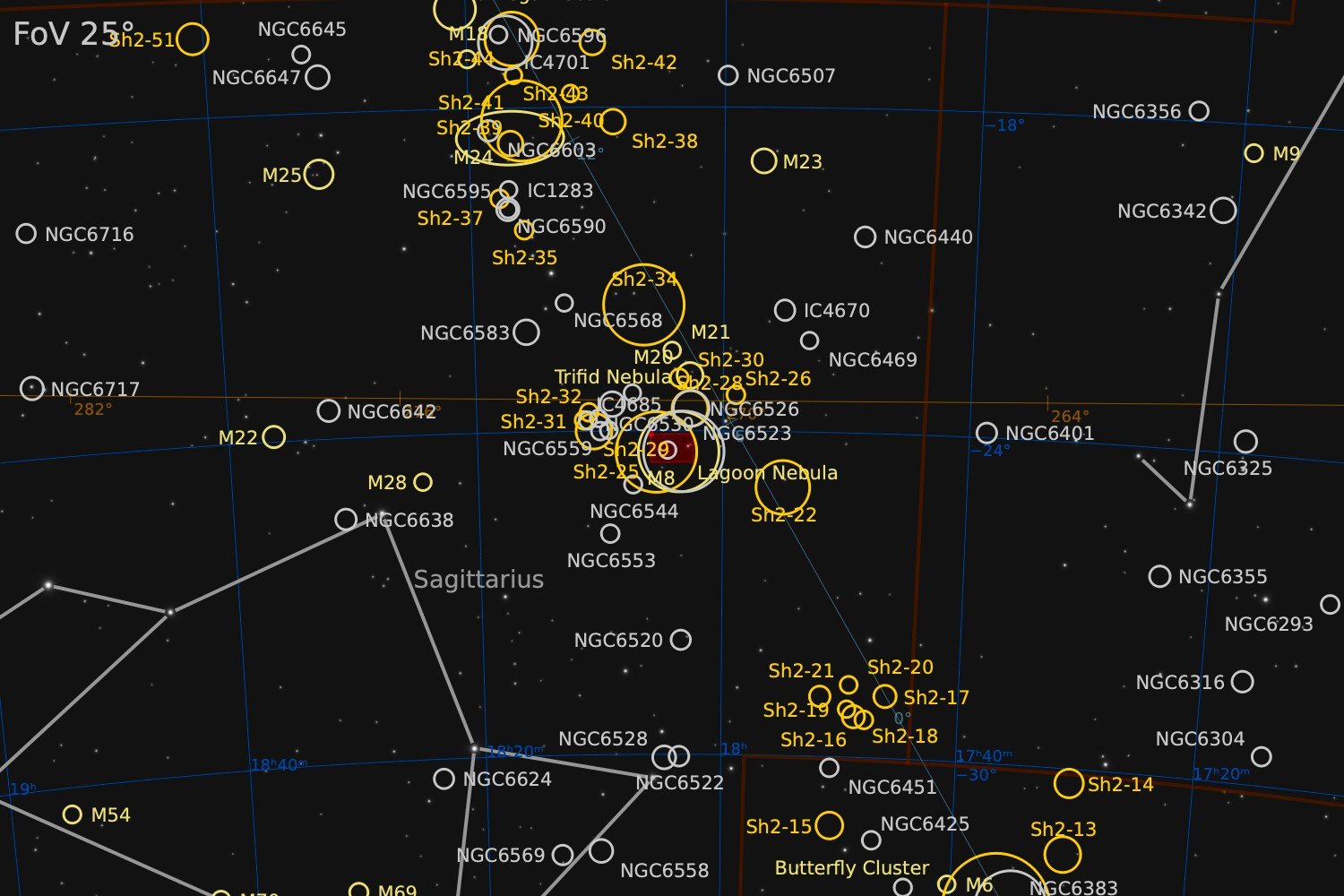M8 | Sh2-25
NGC 6523, Lagoon Nebula
48’ x 32’ | 0.3”/px | 9576 × 6388 px | full resolution
Sagittarius
RA 18h 04m Dec -24° 19’ | 0°



Messier 8, also referred to as the Lagoon Nebula, is a giant interstellar cloud in the constellation Sagittarius. It is classified as an emission nebula and has an H II region. The Lagoon Nebula was discovered by Giovanni Hodierna in 1654 and was later included in Charles Messier's catalog in 1764. It is also an object in the Sharpless II catalog, under number Sh2-25. It is one of only two star-forming nebulae faintly visible to the eye from mid-northern latitudes. Seen with binoculars, it appears as a distinct cloud-like patch with a definite core. Within the nebula is the open cluster NGC 6530. The Lagoon Nebula is estimated to be between 4,000–6,000 light-years away from the Earth. In the sky of Earth, it spans 90' by 40', which translates to an actual dimension of 110 by 50 light years. The nebula contains a number of Bok globules (dark, collapsing clouds of protostellar material), the most prominent of which have been catalogued by E. E. Barnard as B88, B89 and B296. It also includes a funnel-like or tornado-like structure caused by a hot O-type star that emanates ultraviolet light, heating and ionizing gases on the surface of the nebula.
source: Wikipedia
Data Acquisition
Data was collected over 13 nights during the months of June and July of 2025, using a 14” reflector telescope with full-frame camera at the remote observatory in Spain. Narrowband filters (Ha, OIII and SII, all 3nm) were used to gather the data. A total of approximately 19 hours of data was combined to create the final image.
Location Remote hosting facility IC Astronomy in Oria, Spain (37°N 2°W)
Sessions
Frames
Equipment
Telescope
Mount
Camera
Filters
Guiding
Accessoires
Software
Planewave CDK14 (2563mm @ f/7.2), Optec Gemini Rotating focuser
10Micron GM2000HPS, custom pier
Moravian C3-61000 Pro (full frame), cooled to -10 ºC
Chroma 2” Ha, OIII, SII (3nm) unmounted, Moravian filterwheel L, 7-position
Unguided
Compulab Tensor I-22, Dragonfly, Pegasus Ultimate Powerbox v2
Voyager Advanced, Viking, Mountwizzard4, Astroplanner, PixInsight 1.9.3
Processing
All processing was done in Pixsinsight unless stated otherwise. Default features were enhanced using scripts and tools from RC-Astro, SetiAstro, GraXpert, CosmicPhotons and others. Images were calibrated using 50 Darks, 50 Flats, and 50 Flat-Darks, registered and integrated using WeightedBatchPreProcessing (WBPP). The processing workflow diagram below outlines the steps taken to create the final image.
The nebula is almost a bit too large to completely fit into the Field of View of this setup. That means that there is no real area that can be considered background. An attempt to do background correction resulted in some very drastic changes in the overall look of the image, which did not seem to be the intended outcome. Therefore no background correction was performed.
To create an image according to the Hubble palette, the general approach as described here was used. However, stretching using automated algorithms like the SmartStretch scriptlet in PMGUI, or the Statistical Stretch method from SetiAstro yielded very different results. SmartStretch works towards a certain background value, but as mentioned above, this image is all nebula and does not really have background values. The result was a very dark image, even with aggressive stretching parameters. Statistical Stretch works towards an average overall image brightness, and this worked much better in this case. The value that was chosen was 0.2, leaving a bit of room for more selective changes later in the process. Often with narrowband images, one of the three channels is pretty dominant (most often Ha). But in this case, all three colour channels showed a lot of signal and created lots of colours, structure and depth in the final image. As they were all easily stretched to similar average values, NarrowbandNormalisation only needed some small tweaks to get to the final image.
Each individual channel shows a lot of signal and detail. Lots of structure from the SII eventually shows up as bright yellow edges in the final image as well as magenta nebulosity structures where it overlaps with OIII. The bright central area of the nebula in OIII is very dominant in the center of the final image, showing lots of blue.
As the processing was coming to the end, I did want to bring out a little more depth and pop into the image, so with the stars already in place, I did add a bit of contrast to the dark structures using DarkStructureEnhance, and brightened up the reds and the yellows using an appropriate colour mask.
The rest of the editing followed a standard processing workflow.
Processing workflow (click to enlarge)
This image has been published on Astrobin.

